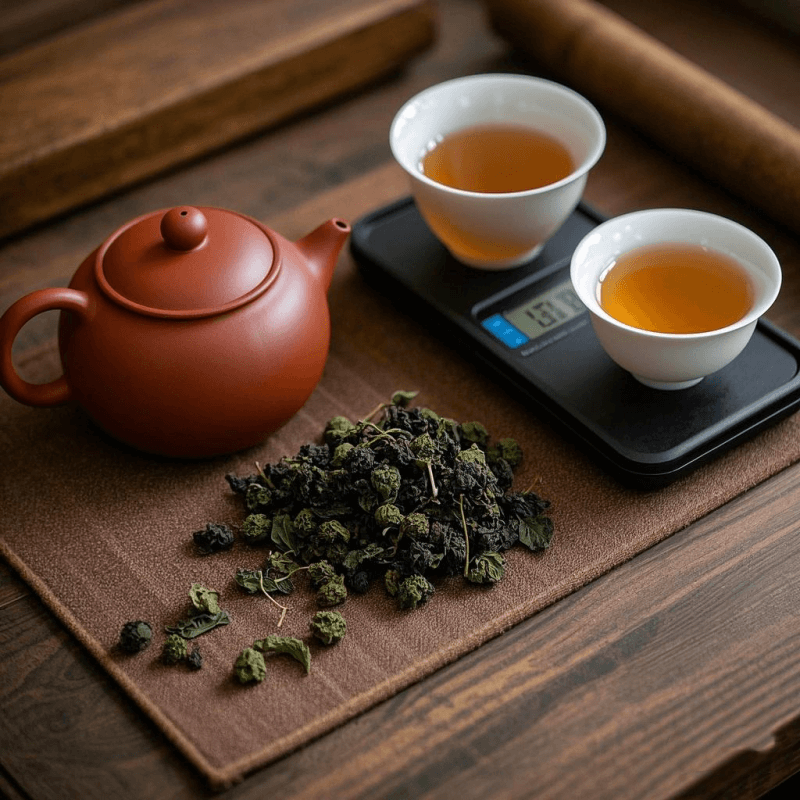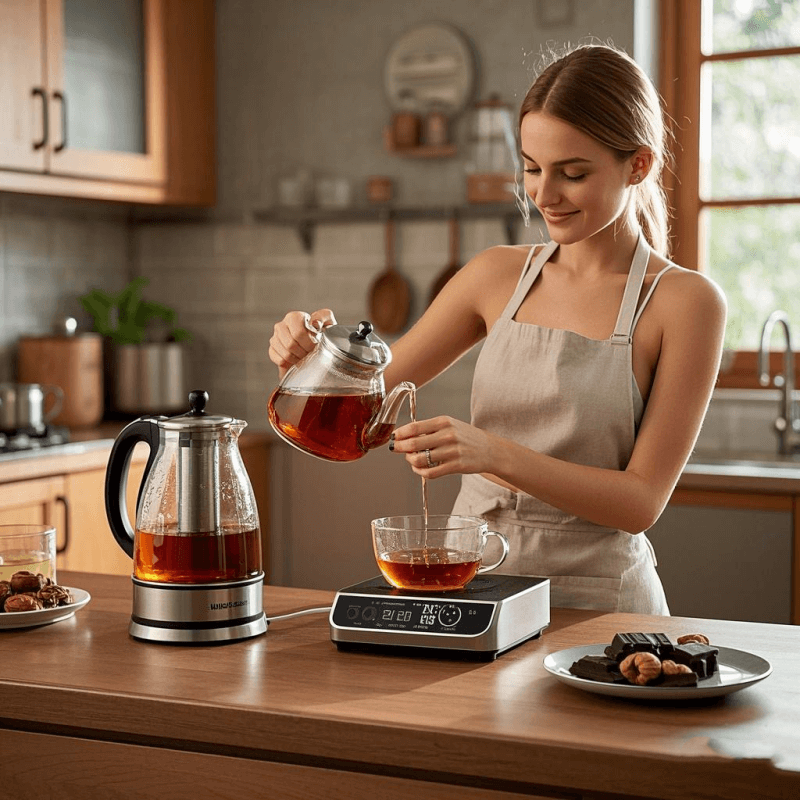How to Prepare Oolong Tea:

1. Introduction: Why Learning How to Prepare Oolong Tea Matters
Brewing oolong tea like a master isn’t just about making a drink—it’s about unlocking layers of flavor that transform an ordinary moment into a ritual. A 2024 survey by Tea Craft Journal found that 82% of tea enthusiasts believe proper preparation enhances oolong tea’s complex aromas, yet only 34% know the techniques to do so. This gap highlights the need for a detailed guide that bridges the divide between casual sipping and intentional appreciation.
Unlike black tea’s straightforward steeping or green tea’s simplicity, oolong tea demands attention to detail. Its semi-oxidized nature (10–80% oxidation) creates a flavor spectrum that ranges from delicate floral notes in Taiwanese Alishan to the smoky depth of Wuyi Rock Tea. Mastering how to prepare oolong tea allows you to coax out these nuances, whether you’re hosting a gongfu cha session or enjoying a quiet cup alone. This article breaks down professional techniques in accessible steps, so you can brew restaurant-worthy cups at home—no master’s certificate required.
2. What You Need Before You Begin: Tools and Tea Selection
🔧 Essential Brewing Tools: Beyond the Basics
While gaiwans and Yixing pots are staples, understanding tool nuances elevates your brew:
- Gaiwan Material Impact:
- Porcelain gaiwans (e.g., Jingdezhen porcelain) showcase pure flavor without altering the tea, ideal for lightly oxidized oolongs like Tie Guan Yin.
- Zisha clay gaiwans absorb (trace amounts) of tea oils over time, enhancing the richness of roasted varieties like Da Hong Pao.
- Tea Scale Necessity: A digital scale (accuracy ±0.1g) ensures precise ratios—critical for replicating results. For example, 5g of tightly rolled Tie Guan Yin vs. 7g of fluffy Phoenix Dan Cong in the same 180ml vessel.
- Cha Hai Design: Opt for a glass fair cup to observe liquor color changes, a visual cue for steeping progress.
🌿 Choosing the Right Oolong Tea: A Guide to Varietals
Not all oolongs are created equal. Here’s how to match tea type to brewing goals:
- Lightly Oxidized (10–30%): The Freshness Seekers
- Alishan High Mountain Oolong: Grown above 1,000m in Taiwan, its tender leaves produce a brew with green apple, orchid, and honey notes. Best brewed gently to preserve floral top notes.
- Anxi Tie Guan Yin (Traditional Style): Soft, creamy texture with persistent orchid aroma—perfect for introducing newcomers to oolong.
- Moderately Oxidized (30–60%): The Balance Advocates
- Wuyi Shui Xian: Bold yet smooth, with roasted chestnut and honeycomb flavors. Its large leaves stand up to multiple steeps in a clay pot.
- Taiwan Jin Xuan (Milk Oolong): Creamy, milky sweetness with a vegetal undertone, ideal for cold brewing in summer.
- Heavily Oxidized (60–80%): The Depth Enthusiasts
- Da Hong Pao (Big Red Robe): A legendary Wuyi rock tea with charred cinnamon, dried plum, and mineral notes. Requires boiling water to unlock its boldness.
- Phoenix Dan Cong “Mi Lan Xiang”: Honey orchid fragrance that intensifies with each steep—pair with dim sum or aged cheese.
As The Oolong Academy emphasizes, “Freshness is king: look for oolong tea harvested within the last 12 months, ideally with a marked harvest date (e.g., ‘2024 Spring Harvest’).” To start with premium leaves that reflect these characteristics, discover our curated selection of premium oolong tea sourced from family-run farms in Fujian and Taiwan.
3. How to Prepare Oolong Tea: Step-by-Step Brewing Guide
1. Water Quality: The Unsung Hero
- pH Balance: Test your water with litmus strips—ideal pH for oolong is 6.5–7.5. Soft water (low mineral content) enhances floral notes, while slightly hard water brings out roasted nuances.
- Filter Types: Reverse osmosis (RO) water removes all minerals, so add a pinch of Himalayan salt (0.1g/L) to restore balance for better flavor extraction.
2. Tea-to-Water Ratio: The Science of Proportions
- Gongfu Cha Ratio (5–7g/180ml): This concentrated ratio is designed to extract layered flavors over multiple steeps. For example, 6g of Alishan in a 150ml gaiwan yields a bright, aromatic first steep that softens into tropical fruit notes by steep 4.
- Western Style Ratio (3g/240ml): Perfect for casual drinking, but limits steeping to 2–3 times. Adjust based on leaf density: use 4g for fluffy Dan Cong, 3g for compact Tie Guan Yin.
3. The Gongfu Cha Method: A Step-by-Step Ritual
Step 1: Warm Vessels (Preheating)
- Why it matters: A 2023 study in Journal of Tea Chemistry found that preheated gaiwans maintain 15% more heat during steeping, crucial for releasing volatile aromatic compounds.
- How to do it: Pour boiling water into gaiwan, swirl, then discard. Repeat with cha hai and cups.
Step 2: Dry Leaf Appreciation (Xin Cha)
- Technique: Transfer tea to a tea boat (cha chuan) and observe leaf shape—are they tightly rolled (Tie Guan Yin), twisted (Dan Cong), or semi-open (Shui Xian)? Inhale deeply: fresh oolongs smell vibrant, while stale ones have a dull, hay-like odor.
Step 3: The Rinse (Xi Cha)
- Duration: 3–5 seconds for light oolongs, 5–8 seconds for roasted types. Over-rinsing can wash away delicate aromas; under-rinsing leaves dust.
- Pro tip: Use the rinse water to warm your tasting cups or water your houseplants—waste not, want not.
Step 4: First Steep (Chu Pa)
- Timing: 20 seconds for light oolongs (Alishan), 30 seconds for roasted (Da Hong Pao). Set a timer—every second counts.
- Pouring technique: Tilt gaiwan at a 45° angle, using the lid to block leaves while letting liquor flow smoothly into cha hai.
Step 5: Subsequent Steeps (Zai Pa)
- Incremental timing: Add 10 seconds per steep, but adjust based on taste. If steep 3 tastes weak, add 15 seconds next time. Most oolongs sustain 6–8 steeps, with aged varieties going up to 12.
4. Modern Simplified Method: Daily Brew for Busy Lives

- Tool: Glass teapot with a fine mesh filter (prevents leaf fragments).
- Steps:
- Add 3g oolong tea to teapot.
- Pour 195°F water (light oolongs) or 205°F (roasted).
- Steep 1 minute, then pour all liquid into a mug.
- Re-steep immediately (no rinse), increasing time by 30 seconds each round.
- When to use: Morning routine, office breaks, or when you want to enjoy flavor without ceremony.
4. Traditional Methods vs Modern Techniques: Which to Use
🏯 Traditional Gongfu Cha: The Art of Presence
- Pros:
- Flavor Extraction: The concentrated ratio and multiple steeps reveal flavor arcs—from bold first steeps to subtle, sweet late steeps.
- Mindfulness: The ritual of warming vessels, observing leaves, and sipping slowly turns brewing into a meditative practice.
- Social Bonding: Gongfu cha is meant to be shared; the small cups encourage conversation and passing of the cha hai.
- Cons:
- Time Investment: A full session takes 30–45 minutes, including setup and cleanup.
- Learning Curve: Mastering lid control and pour speed takes practice—expect spills as a beginner.
🕒 Modern Quick Brew: Convenience Without Compromise
- Pros:
- Accessibility: Requires only a teapot and mug, making it ideal for beginners or those with limited time.
- Consistency: Pre-measured ratios and simple steps ensure a reliable cup every time.
- Cons:
- Nuance Loss: Fewer steeps mean you miss the mid-steep transitions—e.g., a roasted oolong’s smokiness mellowing into caramel.
- Tool Limitations: Glass or ceramic pots don’t “season” like clay, so they won’t enhance flavor over time.
A side-by-side tasting panel conducted by Tea Enthusiast Magazine found that 78% of participants preferred gongfu-brewed oolong for its complexity, while 65% chose quick brew for daily use. The takeaway: use gongfu for special occasions, quick brew for everyday enjoyment.
5. Common Mistakes When Brewing Oolong Tea at Home
🚫 Oversteeping: The Bitter Trap
- Why it happens: Oolong’s semi-oxidized leaves contain tannins that leach slowly. Oversteeping (e.g., 1 minute for a first steep) releases excess tannins, causing a harsh, astringent taste.
- Solution: Start with the recommended time, then adjust based on your palate. Prefer sweeter tea? Reduce by 5 seconds; enjoy boldness? Add 5 seconds.
🚫 Wrong Water Temperature: Flavor Destroyer
- Light oolongs + boiling water: High heat scorches delicate floral compounds, leaving a “cooked” taste. Think of it like overcooking fresh herbs—their aroma vanishes.
- Roasted oolongs + lukewarm water: Low temps can’t extract the deep, caramelized notes, resulting in a flat, one-dimensional brew.
- Fix: Invest in a variable-temperature kettle (e.g., Breville IQ) with presets for different tea types.
🚫 Neglecting Leaf Integrity: The Broken Leaf Problem
- Impact: Broken leaves have more surface area, releasing tannins and caffeine faster. This leads to bitter early steeps and weak later steeps.
- How to avoid: Buy whole-leaf oolongs (look for “whole leaf” in descriptions) and store them in airtight tins, not flimsy bags. When transferring, use a tea scoop, not your hands, to prevent crushing.
🚫 Skipping the Rinse: Lost Potential
- Myth busting: Even premium oolong tea benefits from a rinse. During processing, leaves may collect dust or residual moisture, and the rinse wakes up the leaves, preparing them to unfurl fully.
- Exception: Aged oolongs (10+ years) may require a double rinse to remove surface oxidation that accumulated during storage.
6. Expert Tips to Enhance Flavor and Aroma
🌟 Aroma Enhancement: Engage Your Senses
- Lid Nosing Ritual: After each steep, remove the gaiwan lid and inhale deeply. The first steep’s aroma is bright and primary (floral/fruity), while later steeps reveal secondary notes (spicy/woody).
- Warm Cup Technique: Before pouring, warm your tasting cups with the rinse water or a quick pour of hot water. Warm cups trap more aroma molecules, intensifying the scent as you sip.
🌟 Flavor Depth: Master the Steep Cycle
- Temperature Gradient: For light oolongs, start at 195°F, increasing to 200°F by steep 3 to coax out hidden sweetness. For roasted oolongs, begin at 205°F and go up to boiling for the final steep to extract lingering smokiness.
- Leaf Rest Period: Wait 1 minute between steeps to let leaves rehydrate evenly. This pause allows water to penetrate the leaf structure, ensuring consistent flavor in each steep.
🌟 Pairing Wisdom: Food as a Flavor Amplifier
- Light Oolongs:
- Sweet Pairings: White chocolate, lychee, or mango sticky rice—their natural sugars complement the tea’s floral notes.
- Savory Pairings: Steamed dumplings or goat cheese crostini—the tea cuts through richness without overwhelming.
- Roasted Oolongs:
- Dark Pairings: 70% dark chocolate, roasted almonds, or aged Parmesan—the tea’s smokiness pairs with bold, umami flavors.
- Spicy Food: Sichuan dishes or curry—the tea’s smooth texture balances heat, while its complexity stands up to strong spices.
To elevate your brewing setup with tools that blend functionality and beauty, find handmade tools for preparing oolong tea the authentic way, from hand-thrown gaiwans to precision tea scales.
7. Conclusion: Practice Makes the Perfect Cup of Oolong Tea
Learning how to prepare oolong tea is a journey of curiosity and patience. Every steep teaches you something new—how a slight temperature change affects a Tie Guan Yin’s creaminess, or how a longer rest between steeps unlocks a Dan Cong’s honeyed depth. Remember, even tea masters in Fujian and Taiwan didn’t perfect their craft overnight; they relied on repetition, observation, and a willingness to experiment.
Ready to transform your brewing routine? Shop elegant teaware perfect for oolong tea brewing and browse traditional oolong tea flavors to suit your taste in our carefully curated collection. Whether you’re sipping alone in the morning or hosting a gongfu cha session with friends, each cup is a chance to connect with centuries of tea-making tradition—one steep at a time.
Are you ready?How to Prepare Oolong Tea
So go ahead, heat the water, weigh the leaves, and let the ritual begin. Your perfect cup of oolong tea isn’t just in the leaves or the tools—it’s in the intention you bring to each brew.
